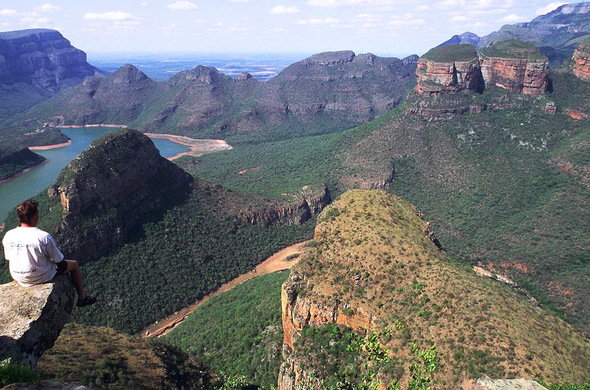
Conservation areas such as the Kruger National Park in South Africa possess attributes akin to the properties of modern cities. Both tend to be managed as closed systems without due regard to the external forces that shape their function and structure. Wherein conservation areas provide the means of producing and securing natural capital, cities offer the means of transforming and distributing this capital as economic goods and services.
Arguably, the production and flow of natural capital result from ecological processes, but the ways in which the associated benefits accumulate to human beneficiaries are governed by a complex system of societal norms, rules and organizational processes that manifest in the form of cities. In this way, the management of water in conservation areas generates useful practical lessons that can be used to influence the establishment and maintenance of water systems in cities.
For a long time, the management of surface water has been at the heart of water provision programmes in both conservation areas and cities. However, with increasing impacts of climate change, compounded by high levels of abstraction and regulation of river flows, managers of conservation areas have become progressively aware of the risks of water shortages and the need to negotiate and manage assured supplies. Not surprisingly, perhaps, cities have been slow to respond to these consequences of climate change.
In Kruger National Park, for example, management realised in the late 1980s that it needed to look beyond water adaptive strategies to develop transformative solutions to the emerging climate change challenges. To achieve this, management had to acknowledge the need for a shift towards a functional balance between adaptation and transformation.
Prior to the 1980s, most water decisions in Kruger were in a sense designed to make the park less dependent on upstream water sources, and in so doing to insulate the park from the consequences of climate change. Through an artificial water provision policy, 365 boreholes and 50 earth dams were constructed to provide water for the wildlife populations in the park.
By focusing on self-reliance and away from co-dependency, the park management was ‘artificially’ able to reduce the risks of water shortages that would prejudice the operations of the park. In this sense, the goal of management was to avoid chaos through adaptation.
In the 1990s, however, management begun to realize that it had no control over upstream water uses and the consequences of climate change. With the emergence of a democratic government in South Africa in 1994, there followed a process of water policy reform based on the incorporation of environmental and climatic considerations into legislation.
The transition into the democratic era coincided with a change in government policy from one in which environmental and climatic issues were not featured strongly in water strategies to one in which there was a legal requirement to provide water to sustain the environment.
The management in Kruger National Park realised that their adaptive water strategies had become increasingly untenable under conditions where thresholds were ever-changing and always in transition. This eventually necessitated the adoption of more transformative strategies that made possible the development of a sophisticated approach for calculating environmental water requirements for Kruger National Park.
The combination of the legal requirement for securing water for the environment, the emerging scientific ability to determine and defend estimations of environmental water requirements and the growing appreciation for the unforeseen impacts of climate change emanating from artificial supplies of water encouraged park management to rescind the previous water provision policy.
While some efforts were still directed toward developing adaptive capacity, these were not appropriate for increasing system resilience. In some circumstances, such efforts were not even desirable as weather patterns shifted to more intense and frequent events. This is because the emergent weather shifts amplified the consequences of climate change and increased the likelihood of a greater number of thresholds being crossed, possibly irreversibly.

This begs the question whether adaptation, as it relates to the current drought in Cape Town, should be a process of deliberate transformative change, rather than defensive actions seeking to protect cores, assets or functions. Cape Town is currently in the grip of a calamitous drought that has seen South Africa’s second-most populous city facing the prospect of having its taps running dry on Day Zero.
However, with the recent declaration of the drought as a national disaster and the pushing back of Day Zero from 12 April to 27 August, Cape Town now needs to look beyond adaptive strategies to develop transformative solutions to the current water crisis.
The declaration of a national disaster expands responsibilities and accountability beyond the local government sphere to include the national government that is expected to tackle the crisis head-on and ensure immediate relief efforts. These recent developments will hopefully allow the city managers in Cape Town to refocus their attention and capacities to the long term climate change challenges affecting most South African cities. More importantly, they will enable the city authorities to design long term transformative water strategies that are generative of change; as opposed to adaptive water strategies which are often responsive to change, particularly under conditions of severe water scarcity.
Adaptation in this context denotes the capacity of a city to adjust its responses to change in external drivers. Such adaptation, however, cannot necessarily transform the inherent links between the city and its external environment and the feedback mechanisms between them. While adaptation may lead to some changes in the internal structures and activities of the city, it will usually remain confined to the local scale at which adaptation was implemented.
On the contrary, transformation is necessary in situations where adaptation remains confined to the local scale and does not affect the external environment. This is especially so when dominant feedbacks between the city and the external environment do not change. Efforts to build a climate resilient Cape Town city will certainly require long term transformative water interventions. Future prospects will be defined by the capacity of the city to transform rather than to adapt to emergent conditions. What is needed is transformative water security that emphasizes continuous experimentation and learning in an ongoing process of defining and balancing thresholds. It is only such change that will enable the city to move to a new configuration defined by new state variables.
